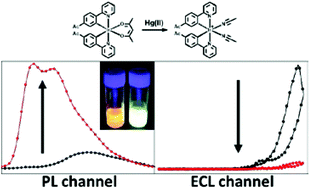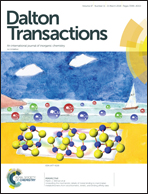Ir(iii) complex-based phosphorescence and electrochemiluminescence chemodosimetric probes for Hg(ii) ions with high selectivity and sensitivity†
Abstract
Mercury, one of the most prevalent toxic metal elements, poses severe risks to human health and the environment. Several molecular probes have been developed for colorimetric and fluorometric detection of Hg(II) ions. Nevertheless, development of a rapid, selective, and sensitive probe for Hg(II) ions remains important. Herein, we report three Ir(III) complex-based phosphorescence and electrochemiluminescence chemodosimeters for the selective detection of Hg(II) ions. The acetylacetonate ancillary ligand of probe 1 reacts selectively with the Hg(II) ion, inducing phosphorescence enhancement with a concomitant blue-shift. Meanwhile, the Hg(II) ion selectively quenches the phosphorescence of probe 2. Probes 1 and 2 showed low detection limits (LOD) of 73 and 160 nM, respectively. In addition, the Hg(II) ion level was successfully monitored by the electrochemiluminescence decrement of probe 9 with a good linear correlation between 0 and 40 μM, with a detection limit of 170 pM.



 Please wait while we load your content...
Please wait while we load your content...